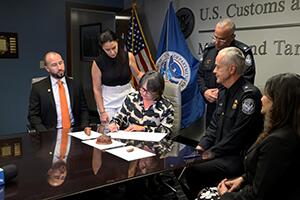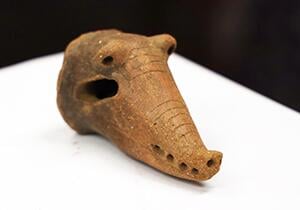MIAMI — U.S. Customs and Border Protection (CBP) returned three historic artifacts on Thursday from the Caribbean Archaeological Subregion that were seized from a passenger that arrived at the Orlando International Airport without documentation permitting him to lawfully remove them from the Republic of Costa Rica (Costa Rica).
In December 2017, a U.S. lawful permanent resident from Deltona, Florida, arrived at Orlando International Airport from San Jose, Costa Rica. After being referred to secondary inspection, CBP agricultural specialists suspected that the individual might be transporting protected artifacts.
Specialists of the National Museum of Costa Rica described the artifacts as follows: the first one is a tripod pot, which is missing its three 3 supports and it is decorated in some areas with red clay, combined with the natural color of the paste and decorations modeled in zoomorphic shapes. The second one is a hollow support, known as a rattle, with a zoomorphic motif (mammal head). The third is a fragment of decoration that was supported by a vase with high supports. According to archeological research, the objects were used for funerary or domestic contexts in the period established between 300 B.C. and 880 A.D.
CBP notified Costa Rica which filed a petition for their return stating the artifacts were stolen and are owned by the people of Costa Rica pursuant to its cultural patrimony laws. CBP granted Costa Rica’s petition.
On September 14, 2023, the Honorable Ludmila Patricia Ugalde Simionova, Consul General of Costa Rica in Miami, received these artifacts that will now be returned to Costa Rica to continue to tell the story of the First Costa Ricans for ages to come.
“Today, we celebrate the return of Costa Rican cultural heritage to the Costa Rican people, and reaffirm our commitment to reducing the illicit trafficking of art and antiquities,” said Robert Del Toro, Acting Director, Field Operations, Miami and Tampa Field Office.
“CBP plays a significant role in protecting global history by combatting cultural property smuggling,” he continued. “The global black market in antiquities is estimated to be a multibillion-dollar illicit industry. While a monetary value may be placed on these items, the repatriation of cultural property is truly priceless. I am so proud of our employees for their work in discovering these three historic artifacts and ensuring their return to Costa Rica.”
“I wish to underscore the successful efforts made by both Costa Rica and the United States in the repatriation of archaeological objects in recent years. Our cultural heritage holds immeasurable value, serving as a testament to our rich history and identity. Unfortunately, looting and illicit trade of antiquities have endangered our precious artifacts. Through joint initiatives and bilateral agreements, we have been able to recover and repatriate many stolen cultural treasures,” said Ludmila Patricia Ugalde Simionova, Consul General, Consulate of Costa Rica in Miami.
Most countries have laws that protect their cultural property. Art/artifacts/antiquities; archeological and ethnological material are terms used to describe these treasures. These laws include export controls and/ or national ownership of cultural property.
Even if purchased from a business in the country of origin or in another country, legal ownership of such artifacts may be questioned if they are brought into the United States.
The most recent achievement of the excellent relationship between the Government of the United States of America and the Government of Costa Rica has been the signing in January 2021 of the “Memorandum of Understanding on the Imposition of Restrictions on the Importation of Archaeological Material.” This document seeks to protect specific categories of artifacts. If they are encountered without proper authorization, the United States will repatriate the artifacts to Costa Rica.
CBP officers screen international travelers and cargo and search for illicit narcotics, unreported currency, protected cultural property, weapons, counterfeit consumer goods, prohibited agriculture, and other illicit products that could potentially harm the American public, U.S. businesses, and our nation’s safety and economic vitality. Learn more about CBP at www.CBP.gov.

